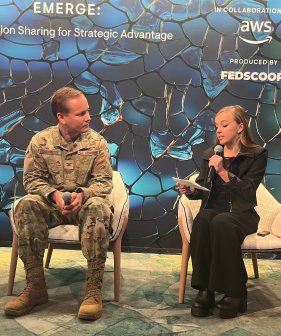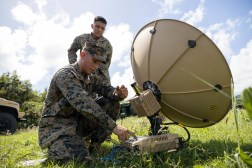- Sponsored
- Insights
MPEs gain momentum for sharing information with allied partners

Defense Department leaders have long recognized the need for more unified information-sharing platforms across the military services. However, as global conflicts increasingly occur without regard to territorial borders, efforts to overcome the technical barriers separating siloed information enclaves among NATO allies and other coalition partners are taking on new urgency and momentum.

Central to those efforts is the renewed vision for creating interoperable “Mission Partner Environments” (MPEs), asserts a new Scoop News Group report sponsored by GDIT. MPEs will allow the military and its trusted partners to communicate and share sensitive information securely and in real-time with allied partners.
MPEs represent a logical extension of the DOD’s Combined Joint All-Domain Command and Control (CJADC2) strategy to federate, jointly access and act upon relevant situational data. However, according to the report, that strategy is also fueling a new commitment to integrate mission and coalition partners into evolving technical standards, capabilities and policies — and toward a global IT environment rather than a U.S.-centric one.
The conflicts and humanitarian crises in Ukraine, the Middle East and elsewhere across the globe have added new urgency to the need for near real-time information exchange across multiple domains. They have also heightened how modern warfare has taken on new dimensions in contrast to previous conflicts, according to the report, including:
- Hybrid Warfare Challenges — Conventional military tactics are being fused with cyber and information warfare. This blending of domains necessitates seamless data sharing to effectively counter and respond to such multifaceted threats.
- Information Warfare and Disinformation — Adversaries in the Ukraine conflict extensively employed disinformation campaigns to shape perceptions and destabilize regions. Interoperable systems enable partner nations to collectively analyze and counter such narratives, ensuring a more comprehensive and coordinated response.
- Dynamic Battlefield Tactics — The conflict has underscored the rapid evolution of the battlefield, where situational awareness is paramount. Interoperability enables partners to share real-time intelligence, adjust strategies and respond swiftly.
- Civil-Military Coordination — The Ukraine conflict has also highlighted the importance of integrating civilian and military efforts in a comprehensive approach. Interoperable systems facilitate coordination among various agencies, ensuring a more cohesive and effective response.
While the concept of MPEs is hardly new, what’s changing is the need to collapse and improve the speed and effectiveness of an expanding array of networks to share information securely with coalition partners, says Eric Tapp, a 21-year veteran of the U.S. Army, and now MPE lead at GDIT.
“MPEs are moving from this massive point-to-point connection on a standalone network to the point where eventually all warfighters working in NATO or working in a coalition environment will be able to communicate effectively and share data,” he explains in the report. What’s missing, he contends, “is the operational art and the art of deployment.”
Tapp, who led MPE development at USCENTCOM before retiring from the Army, highlights “the path to modern MPEs” in the report, the critical need for data-centricity and why MPEs must be transport agnostic if they are to fulfill the vision for real-time data sharing with coalition partners.
Read the full report on developing modern ‘Mission Partner Environments” and how GDIT is helping enhance interoperability with global partners.
This article was produced by Scoop News Group for DefenseScoop and FedScoop and sponsored by GDIT.






